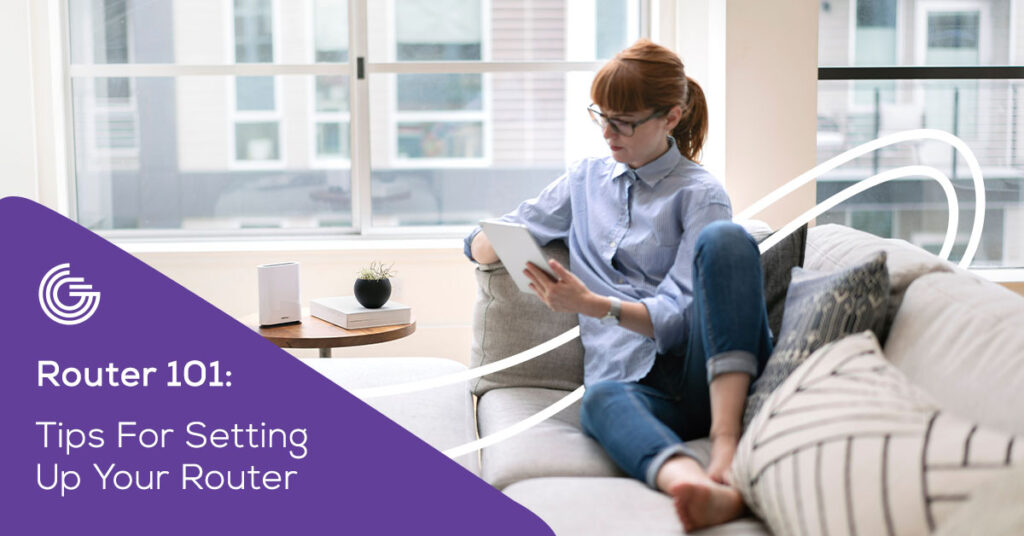
With an increase in virtual meetings, remote work, and online — well, everything — a fast and reliable Internet connection at home is increasingly important, and the right router (and the right setup) is key. That’s why we introduced our new Nokia WiFi 6 Router.
Not exactly sure what we’re talking about? You will. Here are our tips on how to set up your new router and get the most from your Internet service.
What a Router Does and Why It Matters
Your router is a device that takes the wired Internet connection coming into your home and turns it into a wireless signal that all your devices can connect to throughout the house. Routers are essential for any home Internet setup — but a bad router, or suboptimal router placement, can really slow things down.
To understand why, think of the Internet coming into your home as a highway. The higher the speed limit and the more lanes (speed and bandwidth), the quicker and more efficiently the cars (streaming services, online video games, web surfing, phones, tablets, etc.) get where they need to go. Using the same highway metaphor, think of your router as a toll stop. It won’t matter that your GoNetspeed fiber Internet is a 12-lane superhighway if your router is a four-booth, cash-only toll stop; it becomes a chokepoint.
Meet the New GoNetspeed Router
If you want a router to keep up with your Internet service, you need one that is rated for as much bandwidth (or more) as the service you’ve signed up for.
Bandwidth is the amount of data that can be pushed through a device at one time — or, in our metaphor, the number of lanes on the highway. For example, if you have a router that is rated for 450 megabits per second (Mbps) and you have a Gigabit plan (1,000 Mbps), you’re creating a chokepoint — the toll stop has half the lanes of the highway it’s on. We suggest always selecting a router that exceeds the bandwidth of your service so that you have room to grow with higher tiers of service.
With GoNetspeed’s Nokia WiFi 6 Router, you won’t have to worry about chokepoints for a long time. Our new router uses Wi-Fi 6 technology, which has a potential bandwidth of 9,600 Mbps; almost 10x the limit of GoNetspeed’s top plan.
Where to Put Your Wireless Router in Your Home
Once you’ve upgraded to our new router, the next step is to put it in the right spot for the best coverage. Coverage is how far the wireless signal can travel and how strong a signal you’ll get on a device before it becomes ineffective, and placement is key.
Factors like device interference, obstructions, building materials, and square footage can affect router performance, but the most important thing is to place your router in a central location, so that it’s roughly the same distance from all your connected devices.
If you think of the router’s coverage area as a large bubble, stuffing it into a corner of the house is going to place half the bubble outside of your home. A central location is going to ensure you’re getting maximum coverage.
How to Cover Dead Zones with Mesh Extenders
Even with a centrally located router, Internet dead zones can still happen (for any of the reasons mentioned above). GoNetspeed’s WiFi router can cover 1,500 square feet, but if you’re experiencing dead zones — slow speeds, buffering, choppy Internet — you may want to consider installing a few mesh extenders.
A mesh extender is basically a copy of your router that picks up the weak signal in the dead zone and repeats it, creating a new, strong, reliable wireless connection where there wasn’t one before. These mesh extenders only have to be paired with the router once and then plugged into an outlet to work, so they can be placed virtually anywhere.
Interested in mesh extenders? We can help with that! Along with our new router, GoNetspeed also offers wireless mesh extenders that can be added onto your service.
When to Increase Your Plan
If you’ve gone through this list of tips, but slowdowns, stutters, and buffering are still an issue, it might be time to go up a tier in your service plan. This is especially true if you have a lot of people using your Internet at the same time, particularly for things like online gaming, 4k streaming, and virtual reality. If you want to know how much bandwidth you might need, check out this nifty tool provided by Consumer Reports.
If you’re ready to upgrade or want to learn more about our router and mesh extenders, check your address or get in touch with our super-friendly Customer Service team.